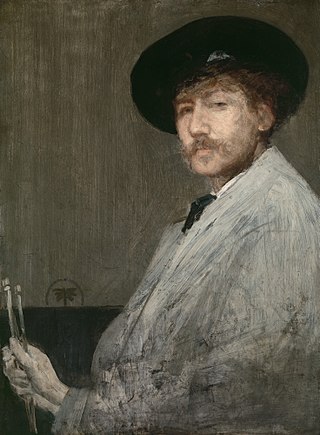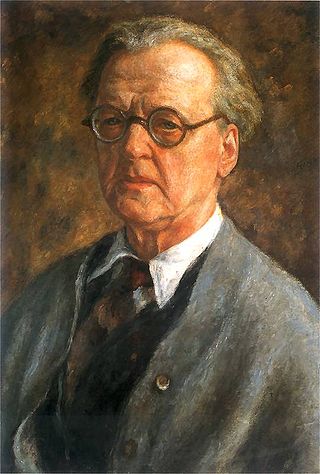
Impressionism was a 19th-century art movement characterized by relatively small, thin, yet visible brush strokes, open composition, emphasis on accurate depiction of light in its changing qualities, ordinary subject matter, unusual visual angles, and inclusion of movement as a crucial element of human perception and experience. Impressionism originated with a group of Paris-based artists whose independent exhibitions brought them to prominence during the 1870s and 1880s.

James Abbott McNeill Whistler was an American painter in oils and watercolor, and printmaker, active during the American Gilded Age and based primarily in the United Kingdom. He eschewed sentimentality and moral allusion in painting and was a leading proponent of the credo "art for art's sake".

The Salon des Refusés, French for "exhibition of rejects", is generally known as an exhibition of works rejected by the jury of the official Paris Salon, but the term is most famously used to refer to the Salon des Refusés of 1863.

Pointillism is a technique of painting in which small, distinct dots of color are applied in patterns to form an image.

Johannes Theodorus 'Jan' Toorop was a Dutch-Indonesian painter, who worked in various styles, including Symbolism, Art Nouveau, and Pointillism. His early work was influenced by the Amsterdam Impressionism movement.

Albert Dubois-Pillet was a French Neo-impressionist painter and a career army officer. He was instrumental in the founding of the Société des Artistes Indépendants, and was one of the first artists to embrace Pointillism.

Théophile "Théo" van Rysselberghe was a Belgian neo-impressionist painter, who played a pivotal role in the European art scene at the turn of the twentieth century.

Paul César Helleu was a French oil painter, pastel artist, drypoint etcher, and designer, best known for his numerous portraits of beautiful society women of the Belle Époque. He also conceived the ceiling mural of night sky constellations for Grand Central Terminal in New York City. He was also the father of Jean Helleu and the grandfather of Jacques Helleu, both artistic directors for Parfums Chanel.

Amsterdam Impressionism was an art movement in late 19th-century Holland. It is associated especially with George Hendrik Breitner and is also known as the School of Allebé.

Philip Wilson Steer was a British painter of landscapes, seascapes plus portraits and figure studies. He was also an influential art teacher. His sea and landscape paintings made him a leading figure in the Impressionist movement in Britain but in time he turned to a more traditional English style, clearly influenced by both John Constable and J. M. W. Turner, and spent more time painting in the countryside rather than on the coast. As a painting tutor at the Slade School of Art for many years he influenced generations of young artists.

Józef Pankiewicz was a Polish impressionist painter, graphic artist and teacher who spent much of his career in France.

Les XX was a group of twenty Belgian painters, designers and sculptors, formed in 1883 by the Brussels lawyer, publisher, and entrepreneur Octave Maus. For ten years, they held an annual exhibition of their art; each year 20 other international artists were also invited to participate in their exhibition. Painters invited include Camille Pissarro, Claude Monet, Georges Seurat, Paul Gauguin, Paul Cézanne (1890), and Vincent van Gogh.

James Sidney Edouard, Baron Ensor was a Belgian painter and printmaker, an important influence on expressionism and surrealism who lived in Ostend for most of his life. He was associated with the artistic group Les XX.

The Royal Academy of Fine Arts of Brussels is an art school established in Brussels, Belgium. It was founded in 1711. Starting from modest beginnings in a single room in Brussels' Town Hall, it has since 1876 been operating from a former convent and orphanage in the Rue du Midi/Zuidstraat, which was converted by the architect Victor Jamaer. The school has played an important role in training leading local artists.

Symphony in White, No. 1, also known as The White Girl, is a painting by James McNeill Whistler. The work shows a woman in full figure standing on a dog skin in front of a beige curtain with a lily in her hand. The colour scheme of the painting is almost entirely white. The model is Joanna Hiffernan, the artist's mistress. Though the painting was originally called The White Girl, Whistler later started calling it Symphony in White, No. 1. By referring to his work in such abstract terms, he intended to emphasize his "art for art's sake" philosophy.

Symphony in White, No. 3, is a painting by James McNeill Whistler. The work shows two women, one sitting on a sofa dressed in white, and the other resting on the floor, with a yellowish dress. The model on the sofa is Joanna Heffernan, the artist's mistress. By calling the painting Symphony in White, No. 3, Whistler intended to emphasise his artistic philosophy of corresponding arts, inspired by the poet Charles Baudelaire. The presence of a fan on the floor shows the influence of Japonisme, which was a popular artistic trend in European art at the time. Whistler was also greatly influenced by his colleague and friend Albert Joseph Moore, and their works show considerable similarities.

Rodolphe Paul Marie Wytsman was a Belgian Impressionist painter. He trained at the Académie Royale des Beaux-Arts in Brussels, and was one of the founding members of Les XX, a group of avant-garde Belgian artists.

Floris Hendrik Verster was a Dutch painter.

Portrait of Marguerite van Mons is an oil-on-canvas painting by Belgian painter Théo van Rysselberghe. The girl portrayed is ten-year-old Marguerite van Mons, depicted shortly after the death of her mother. Théo van Rysselberghe was friends with Emile van Mons, a lawyer and well-known art lover, and painted his daughter Marguerite in June 1886. He had previously painted a portrait of her sister Camille which is now part of the collection of the Niedersächsisches Landesmuseum in Hanover.


















